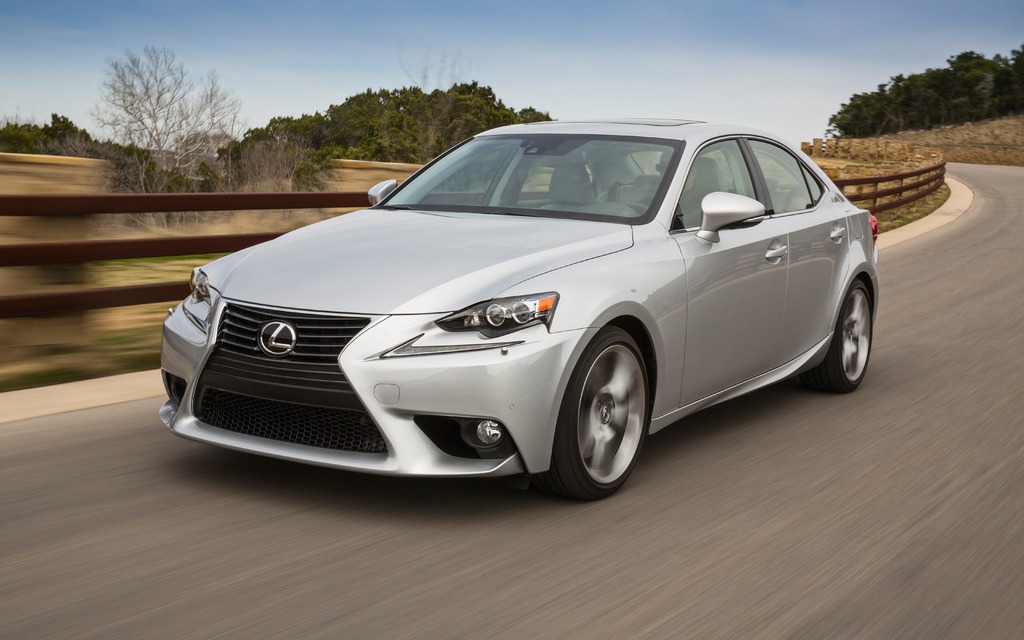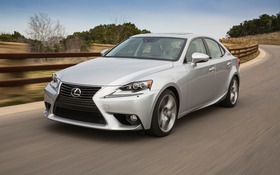2014 Lexus IS, Lexus gets serious with the IS

| Strong points |
|
|---|---|
| Weak points |
|
Lexus is coming upon its quarter-century milestone, and it was the first of the Japanese automakers to offer a high-end luxury automobile. Today, Toyota’s flagship brand has the German luxury sports segment squarely in its crosshairs, and with the all-new 2014 Lexus IS sedans, the Germans should be looking over their shoulders.
A big injection of sport
The IS is Lexus’ entry-level car, but the company has by no means skimped on performance. For 2014 this sport luxury sedan gets an additional dose of sport, with a number of performance-enhancing changes, most of them oriented towards improving the handling.
It also gets a new look, beginning with a new fascia, featuring Lexus’ now familiar “spindle” grille, and a more pronounced front apron. The IS still has a familiar profile, with flared fenders and smooth body lines, but the new front end gives it a more aggressive appearance that better emphasises its sportier stance. HID lighting is standard on all 2014 IS models, with optional LED headlights available only on the IS 350 AWD.
The changes continue beneath the skin, with an improved body structure that uses special adhesives to bond body panels at critical, high-stress areas, as well as additional under-body bracing to increase chassis rigidity. The new steel and aluminum chassis is 10 kilograms lighter and contributes to a 10 percent reduction in overall weight compared to the outgoing model. The wheelbase has been stretched by 70 mm, now at 2,800 mm, and the IS is 85 mm longer overall.
As before, both the IS 250 and IS 350 will be available in rear-wheel drive and full-time all-wheel drive versions, and higher-spec F Sport variations will also be available, a trim level previously available only on LS and GS models. Pricing will be released when the new IS hits dealers later this summer, but the current model starts at $32,250 for the IS 250 RWD and goes up to $51,400 for the IS 350 RWD. Expect F Sport variations to come at a premium over regular models. The V8-powered IS F will continue to be available, but on the current chassis.
The 2014 IS will be available with two engines, a 204 hp, 2.5 litre V6 and a 306 hp, 3.5 litre V6, and they are unchanged from the current model except for slightly revised intake and exhaust tuning, and revised engine mapping. The IS 250 F Sport and all the IS 350 models now have an “intake sound generator” that boosts intake noise when you accelerate, again to enhance the feeling of sportiness from the cabin. The standard transmission is a six-speed automatic, and an eight-speed automatic is optional in the IS 350 RWD model. Fuel consumption ranges from 8.3L/100 km for the IS 250 RWD to 9.5 L/100 km for the IS 350 AWD.
The interior has been reworked and you now sit 20 mm lower than before. This new seating position combines with a new centre console and a steering wheel that is angled three degrees less to encompass you in a sports-car-like cockpit. The F sport version has deeply sculpted front seats that provide ample lateral support for driving at a spirited space, though the foam is a bit firm and might get tiresome after a long stretch on the highway. The front passenger feels a bit more cramped than the driver, mostly because the glove box hangs low and limits legroom if the front seat is adjusted to give ample room for someone sitting in the back seat. One oversight is the location of the cup holders, which are located exactly where you rest your arm on the centre console.
A new dashboard design includes twin round gauges and a centrally located TFT screen on the regular models. F Sport models are equipped with a single round LCD gauge that displays speed and engine rpm, which with the push of a steering wheel mounted button, slides from the centre of the gauge cluster to the right-hand side to reveal an LCD information panel—it is modelled after the dash display in the LFA, as is the steering wheel, yet another indication of the increased sporting penchant that is now part of the IS.
The sound system display screen is now located above the centre air vents, at a higher position than before and is easier to see, and the gearshift knob is now angled slightly towards the driver, mimicking a manual gear shifter.
Rear seat accommodations are fine for two passengers. Head and legroom are marginal for a full sized adult, and my 1.8 metre tall frame fit back there with a little room to spare. There is a seatbelt for a third rear passenger, but the unlucky soul has to unfortunately sit over the driveshaft tunnel, on a raised portion of the seat, so it’s really only for short trips.
Street or track, the IS impresses
On the road, the IS 250 F Sport is a fine example of how much improved the new chassis is over the old. In Sport mode, throttle response is sharp, the electric power steering is well weighed and the transmission shifts with more gusto than in either Normal or Eco modes. The chassis feels rigid and handling is taut, with very little body roll through turns. However, the sporting road-handling leaves you yearning for seat-compressing acceleration, something the 2.5 litre V6 just doesn’t deliver.
To really appreciate the F Sport, you must opt for the IS 350. A few lapping sessions at a small training track near Austin, Texas reveals just how competent the new IS is. We have a BMW 335i and a Mercedes-Benz C350 for comparison, as well as a previous-generation IS 350 F Sport for comparison. It’s a risky proposition for Lexus to include competing models, but the new IS 350 F Sport handled the situation with poise.
In Sport Plus mode (only available in the IS 350 F Sport) it has firmer suspension, exhibits less body roll, has more communicative steering and stronger brakes than all of the other cars. To be fair, the 335i and C350 would have been a better matches if they were equipped their respective M Sport and Sport packages, both of which add about $2000 to the base price.
Without a stopwatch I can’t say for sure, but it felt like I was lapping faster in the BMW, though it also accelerated harder and reached a top speed about 12 km/h higher than the IS. Although the BMW claims similar horsepower, its turbocharged engine produces 30 Nm more toque than the Lexus. The transmission is also a little slow to respond to manual commands in the Lexus, but despite these minor criticisms, it felt crisper and livelier on the racetrack.
The new, sportier Lexus IS has been beefed up and is aimed more at the driving enthusiast than previous generation. If you are expecting a plush, limousine-like ride, you should look elsewhere, but if you actually enjoy driving and are considering a German sports sedan, this new IS should not be overlooked.











